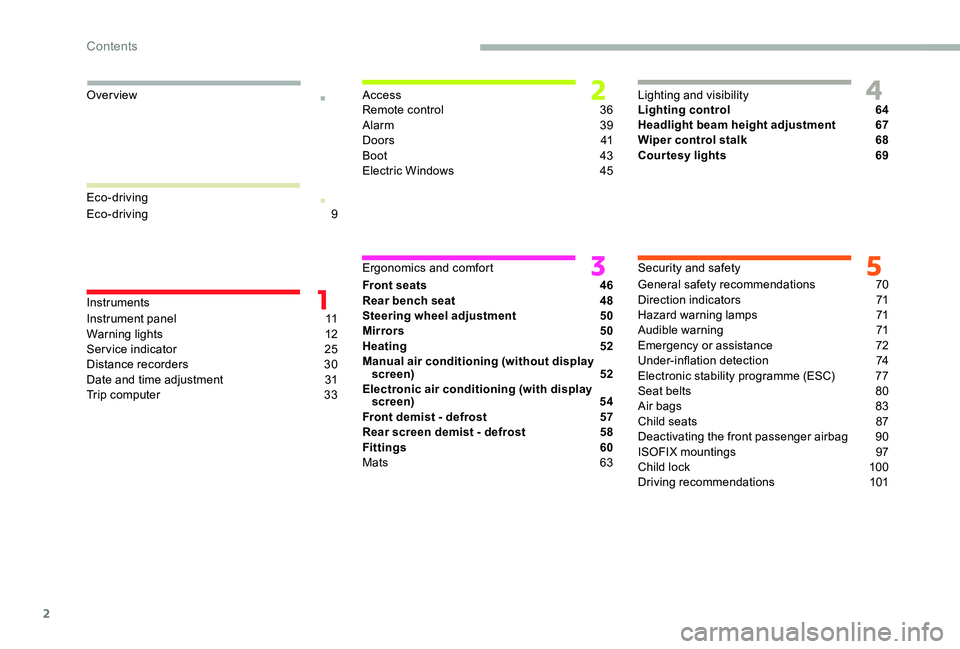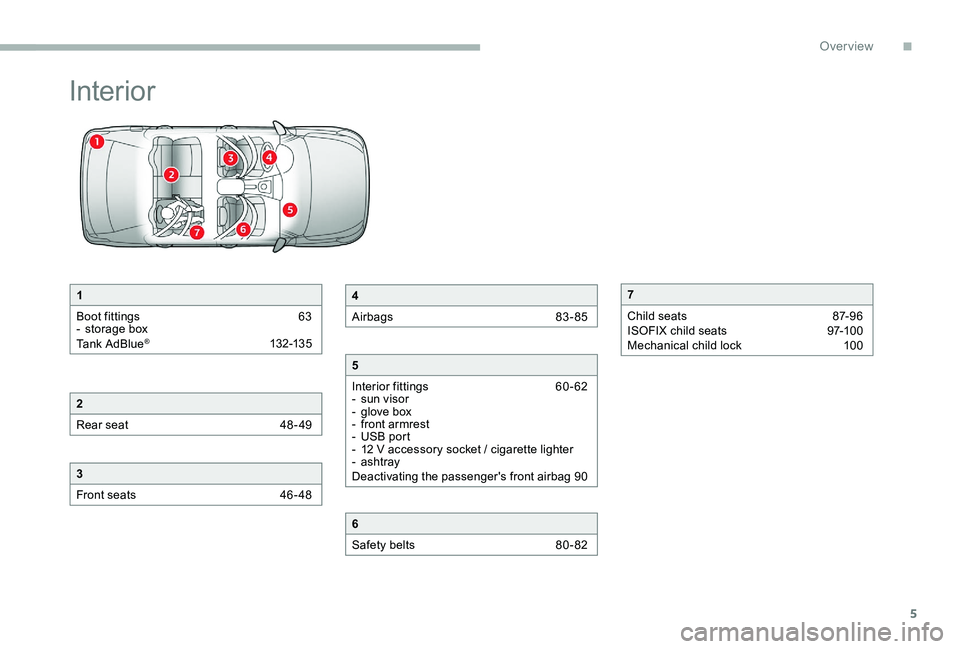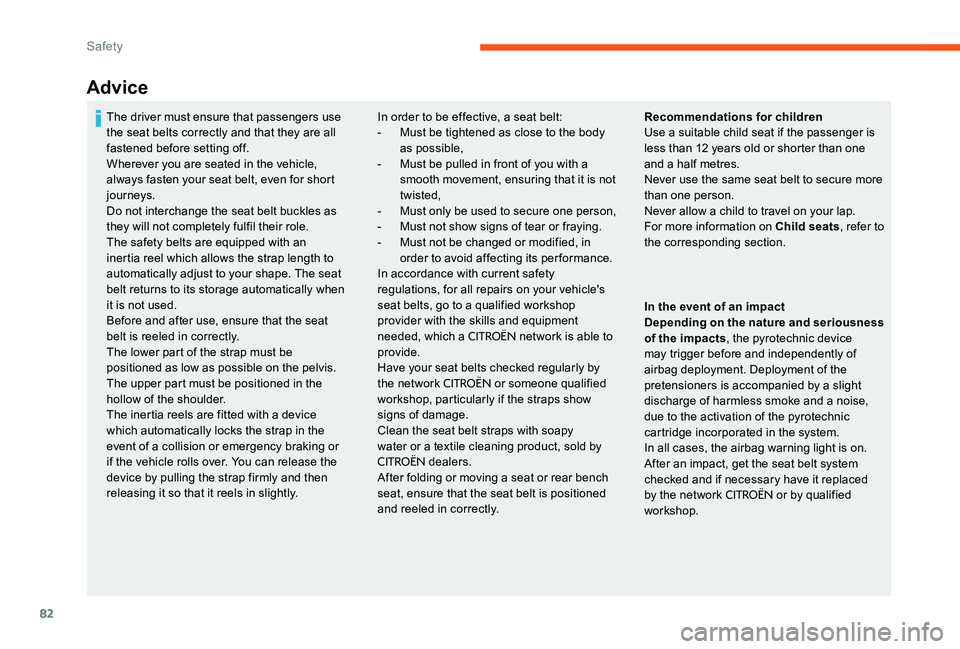belt CITROEN C-ELYSÉE 2017 Handbook (in English)
[x] Cancel search | Manufacturer: CITROEN, Model Year: 2017, Model line: C-ELYSÉE, Model: CITROEN C-ELYSÉE 2017Pages: 306, PDF Size: 9.34 MB
Page 4 of 306

2
.
.
Instrument panel 11
Warning lights 1 2
Service indicator
2
5
Distance recorders
3
0
Date and time adjustment
3
1
Trip computer
3
3Remote control
3
6
Alarm
39
D o o r s
41
Boo
t
43
Electric Windows
4
5
Front seats
4
6
Rear bench seat
4
8
Steering wheel adjustment 5 0
Mirrors 50
Heating
52
Manual air conditioning (without display screen)
52
Electronic air conditioning (with display screen)
5
4
Front demist - defrost
5
7
Rear screen demist - defrost
5
8
Fittings
60
Mats
6
3Lighting control
6
4
Headlight beam height adjustment
6
7
Wiper control stalk
6
8
Courtesy lights
6
9
General safety recommendations
7
0
Direction indicators
7
1
Hazard warning lamps 7 1
Audible warning 7 1
Emergency or assistance
7
2
Under-inflation detection
7
4
Electronic stability programme (ESC)
7
7
Seat belts
8
0
Air bags
8
3
Child seats
87
D
eactivating the front passenger airbag
9
0
ISOFIX mountings
9
7
Child lock
1
00
Driving recommendations
1
01
Eco-driving
9
Eco-driving
Instruments Access
Over view
Ergonomics and comfortLighting and visibility
Security and safety
Contents
Page 7 of 306

5
Interior
1
Boot fittings
6
3
-
s
torage box
Tank AdBlue
® 132-13 5
2
Rear seat
4
8- 49
3
Front seats
4
6 - 48
4
Airbags
8
3-85
5
Interior fittings
6
0-62
-
s
un visor
-
g
love box
-
f
ront armrest
-
U
SB port
-
1
2 V accessory socket / cigarette lighter
-
ashtray
Deactivating the passenger's front airbag
9
0
6
Safety belts
8
0-82
7
Child seats
87
-96
ISOFIX child seats
9
7-100
Mechanical child lock
1
00
.
Over view
Page 16 of 306

14
Warning / indicator lampStateCause Action / Observations
Driver's seat
belt not fastened
or unfastened
/ Front
passenger's
seat belt
unfastenedContinuous or
flashing accompanied
by an increasing
audible signal.The driver has not fastened or
has unfastened his/her seat belt.
The front passenger has
unfastened his/her seat belt. Pull the strap then insert the tongue in the buckle.
Battery charge Continuous. The battery charging circuit has
a fault (dirty or loose terminals,
slack or cut alternator belt, ...). The warning light should go off when the engine is
started.
If it does not go off, contact a
CITROËN dealer or a
qualified workshop.
Engine oil
pressure Continuous.
There is a fault with the engine
lubrication system. You must stop as soon as it is safe to do so.
Park, switch off the ignition and contact a
CITROËN
dealer or a qualified workshop.
Instruments
Page 20 of 306

18
Warning / indicator lampStateCause Action / Observations
Airbags Temporarily on. This warning light comes on for
a few seconds when you turn on
the ignition, then goes off.
This warning light should go off when the engine is started.
If it does not go off, contact a CITROËN dealer or a
qualified workshop.
Continuous. One of the airbag or seat belt
pretensioner systems has a fault. Have it checked by a CITROËN dealer or a qualified
workshop.
Passenger's
airbag system Continuous.
The control switch, located in
the glove box, is set to the " OFF"
position.
The passenger's front airbag is
deactivated.
You can install a "rearward"
facing child seat, unless there is
a fault with the airbags (airbag
warning light on). To activate the passenger front airbag, turn the
control to the "
ON" position.
In this case, do not fit a child seat in the "rear ward"
facing position.
Dynamic
stability control
(DSC/ASR) Continuous.
The button, located at the
bottom left of the dashboard, is
pressed. Its indicator light is on.
The DSC/ASR is deactivated.
DSC: dynamic stability control.
ASR: anti-slip regulation. Press the button to activate the DSC/ASR. Its
indicator light goes off.
The DSC/ASR system is activated automatically when
the vehicle is started.
If the system is deactivated, it is reactivated
automatically once a speed of around 30 mph
(50
km/h) is reached.
Instruments
Page 50 of 306

48
Prolonged use at the is not recommended
for those with sensitive skin.
There is a risk of burns for people whose
perception of heat is impaired (illness,
taking medication, etc.).
There is a risk of overheating the system if
material with insulating properties is used,
such as cushions or seat covers.
Do not use the system:
-
i
f wearing damp clothing,
-
i
f child seats are fitted.
To avoid breaking the heating element in
the seat:
-
d
o not place heavy objects on the
seat,
-
d
o not kneel or stand on the seat,
-
d
o not place sharp objects on the
seat,
-
d
o not spill liquids onto the seat.
To avoid the risk of short-circuit:
-
d
o not use liquid products for cleaning
the seat,
-
n
ever use the heating function when
the seat is damp.
Rear bench seat
Depending on the version, your vehicle is equipped with one of these three bench seats:
- F ixed bench seat.
For removing and refitting it, contact a
CITROËN dealer or a qualified workshop.
-
B
ench seat with fixed one-piece cushion and split folding backrest (left hand 2/3,
right hand 1/3):
-
w
ith fixed head restraints.
-
w
ith adjustable head restraints.
Folding the backrest
F If necessary, move the corresponding front seat forward.
F
C
heck that the corresponding seat belt is
positioned correctly against the backrest
and buckle it. F
P
ull the strap 1 to release the seat
backrest 2 .
F
F
old the seat back 2 on to the cushion.
Ease of use and comfort
Page 51 of 306

49
Returning the backrest to the normal position
F Straighten the seat back 2 and secure it.
F U nbuckle and reposition the seat belt on
the side of the backrest.
When repositioning the seat backrest,
take care not to trap the seat belts.
Ensure that the backrest has latched
properly into place.
Adjustable head restraints
These have one position for use (up) and a
stowed position (down).
They can be removed and are interchangeable
side to side.
To remove a headrest:
F
P
ull the headrest upwards to the stop.
F
P
ress on lug A .
Never drive with the headrests removed;
they must be fitted and correctly adjusted.
3
Ease of use and comfort
Page 82 of 306

80
Seat belts
Front seat belts
LockingSeat belt not fastened /
unfastening warning light
When the ignition is switched on,
this warning light comes on in the
instrument panel, if the driver has
not fastened his/her seat belt.
From approximately 12 mph (20 km/h),
this warning light flashes for two minutes
accompanied by an audible signal of increasing
volume. Once these two minutes have elapsed,
this warning light remains on until the driver
fastens their seat belt.
This warning lamp also illuminates in the
instrument panel if the driver and/or front
passenger unfastens his/her seat belt while
driving.*
The front seat belts are fitted with a pyrotechnic
pretensioning and force limiting system.
This system improves safety in the front
seats in the event of a front or side impact.
Depending on the severity of the impact, the
pretensioning system instantly tightens the seat
belts against the body of the occupants.
The pretensioning seat belts are active when
the ignition is on.
The force limiter reduces the pressure of the
seat belt on the chest of the occupant, thus
improving their protection. F
P
ull the strap then insert the tongue in the
buckle.
F
C
heck that the seat belt is fastened
correctly by pulling the strap.
Unlocking
F Press the red button on the buckle.
F G uide the seat belt as it reels in.
* Depending on the country of sale.
Safety
Page 83 of 306

81
Rear seat belts
Locking
F Pull the strap then insert the tongue in the buckle.
F
C
heck that the seat belt is fastened
correctly by pulling the strap.
Unlocking
F Press the red button on the buckle.
F G uide the seat belt as it reels in.
The right and left rear seats are each fitted with
a three-point inertia reel seat belt.
Depending on version, the centre rear seat is
fitted with a seat belt with or without reel, and
has three or two-point anchorages.
5
Safety
Page 84 of 306

82
Advice
In order to be effective, a seat belt:
- M ust be tightened as close to the body
as possible,
-
M
ust be pulled in front of you with a
smooth movement, ensuring that it is not
twisted,
-
M
ust only be used to secure one person,
-
M
ust not show signs of tear or fraying.
-
M
ust not be changed or modified, in
order to avoid affecting its per formance.
In accordance with current safety
regulations, for all repairs on your vehicle's
seat belts, go to a qualified workshop
provider with the skills and equipment
needed, which a
CITROËN network is able to
provide.
Have your seat belts checked regularly by
the network
CITROËN or someone qualified
workshop, particularly if the straps show
signs of damage.
Clean the seat belt straps with soapy
water or a textile cleaning product, sold by
CITROËN dealers.
After folding or moving a seat or rear bench
seat, ensure that the seat belt is positioned
and reeled in correctly. Recommendations for children
Use a suitable child seat if the passenger is
less than 12 years old or shorter than one
and a half metres.
Never use the same seat belt to secure more
than one person.
Never allow a child to travel on your lap.
For more information on Child seats
, refer to
the corresponding section.
In the event of an impact
Depending on the nature and seriousness
of the impacts , the pyrotechnic device
may trigger before and independently of
airbag deployment. Deployment of the
pretensioners is accompanied by a slight
discharge of harmless smoke and a noise,
due to the activation of the pyrotechnic
cartridge incorporated in the system.
In all cases, the airbag warning light is on.
After an impact, get the seat belt system
checked and if necessary have it replaced
by the network
CITROËN or by qualified
workshop.
The driver must ensure that passengers use
the seat belts correctly and that they are all
fastened before setting off.
Wherever you are seated in the vehicle,
always fasten your seat belt, even for short
journeys.
Do not interchange the seat belt buckles as
they will not completely fulfil their role.
The safety belts are equipped with an
inertia reel which allows the strap length to
automatically adjust to your shape. The seat
belt returns to its storage automatically when
it is not used.
Before and after use, ensure that the seat
belt is reeled in correctly.
The lower part of the strap must be
positioned as low as possible on the pelvis.
The upper part must be positioned in the
hollow of the shoulder.
The inertia reels are fitted with a device
which automatically locks the strap in the
event of a collision or emergency braking or
if the vehicle rolls over. You can release the
device by pulling the strap firmly and then
releasing it so that it reels in slightly.
Safety
Page 85 of 306

83
Air bags
Designed to contribute to the safety of the
occupants in case of violent collisions The
airbags supplement the action of the force-
limiting seat belts.
If a collision occurs, the electronic detectors
record and analyse the front and side impacts
sustained in the impact detection zones:
-
I
n the event of violent impact, the air
bags are deployed instantly and help
better protect occupants of the vehicle;
immediately after the impact, the air
bags deflate rapidly in order not to hinder
the visibility nor the possible exit of the
occupants.
-
I
n the event of a non violent impact, impact
on the back and under certain conditions of
a rollover, the air bags may not deploy; only
the seat belt helps to protect you in these
situations.
The air bags do not operate when the
ignition is switched off.Impact detection zones Front air bags
This equipment will only deploy once. If a
second impact occurs (during the same or
a subsequent accident), the airbag will not
be deployed again. The deployment of an air bag is
accompanied by a slight emission of
smoke and a noise, due to the detonation
of the pyrotechnic charge incorporated in
the system.
This smoke is not harmful, but sensitive
individuals may experience slight irritation.
The detonation noise associated with the
deployment of an air bag may result in a
slight loss of hearing for a short time.
A
Front impact zone.
B Side impact zone. System which protects the driver and front
passenger in the event of a serious front impact
in order to limit the risk of injury to the head and
thorax.
The driver's air bag is fitted in the centre of the
steering wheel; the front passenger's air bag is
fitted in the dashboard above the glove box.
5
Safety